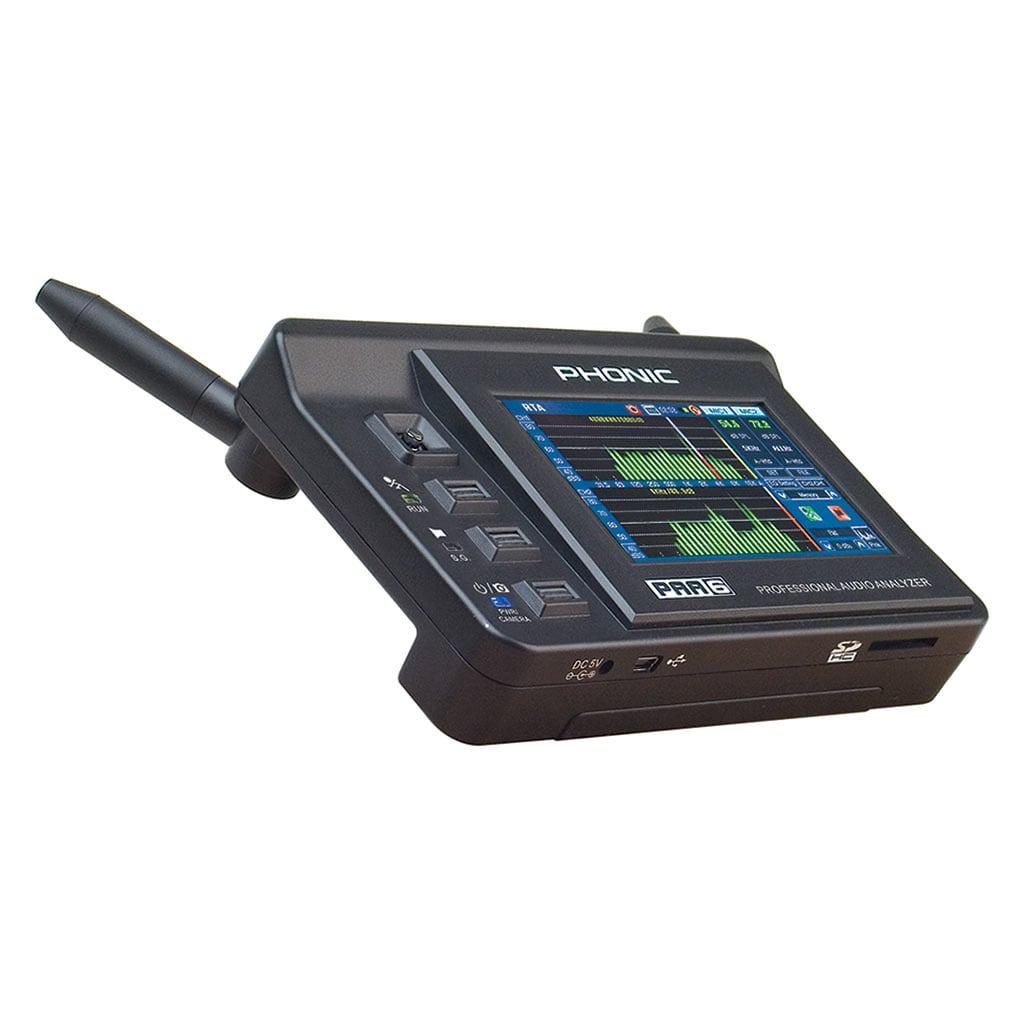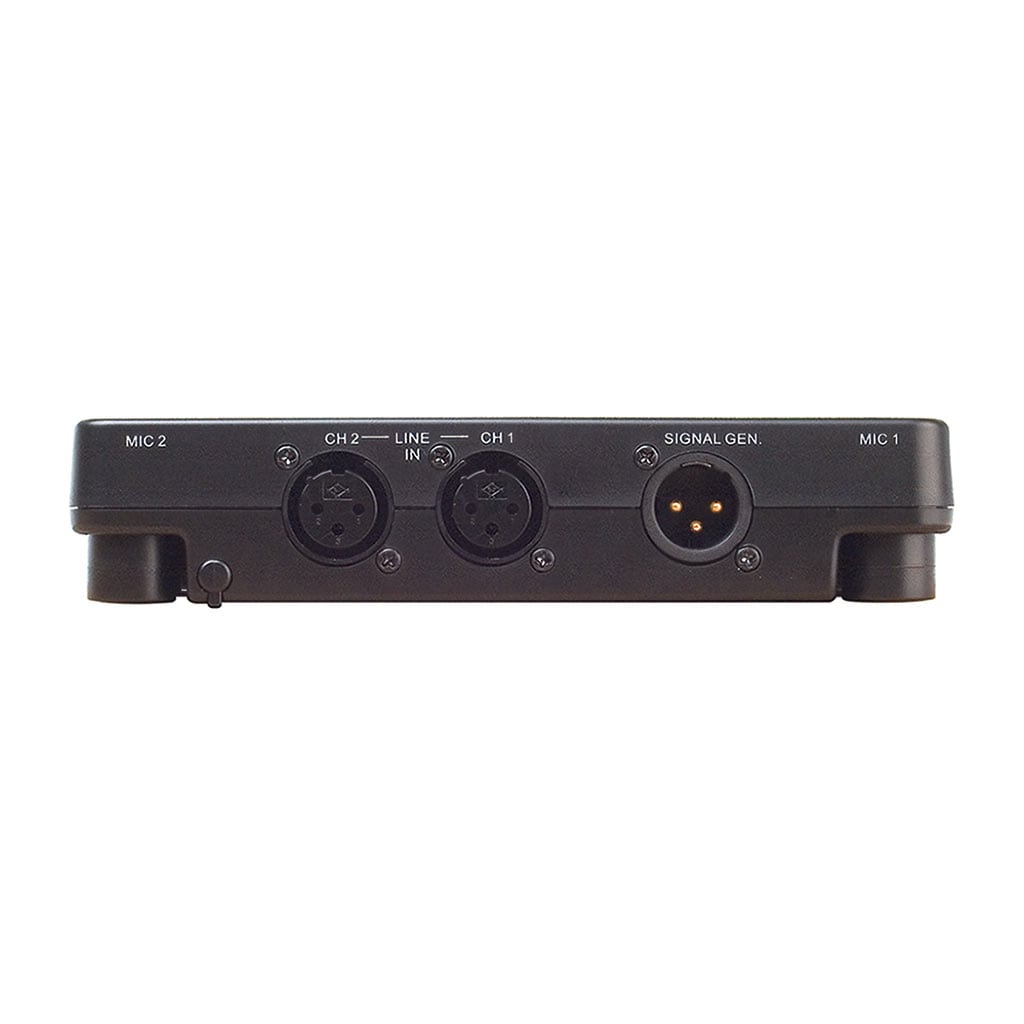Essential tools, such as the Phonic PAA6 Professional Audio Assistant generally wind up at the bottom of pro audio wish lists after esoteric preamps, compressors, and EQs. But more often than not, the key to great sound lies in the utilitarian gear, particularly, the Phonic PAA6 audio analyzer. If you want to get the most out of your studio equipment or PA system, the PAA6 should be at the top of your bucket list. A highly accurate measurement tool, the elegant touch screen interface of the PAA6 offers unfettered access to 61-band real-time spectrum analysis; Fast Fourier Transform (FFT); sound pressure (SPL) and dBu/dBV line voltage measurement; EQ setting; phase and polarity check; LEQ (equivalent continuous noise level); audio oscilloscope; and RT-60 functions. The PAA6 also has two built-in condenser measurement mics that can be used in six different positions. If sound is your product or passion, the Phonic PAA6 is perhaps the wisest investment you can make for your studio or sound reproduction system. Whether you’re setting up monitors, treating room characteristics, calibrating listening levels, or want to know the harmonic distortion and noise characteristics of your workhorse preamps to ensure clean mixes, the Phonic PAA6 is your key to the best possible quality sound.
Outside The Box
All features, functions, and controls of the PAA6 can be viewed and adjusted via its 480 x 272 LCD color touch screen. To the left of the touch screen are four buttons including: Directional Control, which selects manual control and onscreen zone; Run/Stop Button and Indicator to activate the currently selected function; Signal Generator Button and Indicator; and Power Button and Indicator. On either side of the PAA6 are built-in measurement condenser microphones, which can be set in six different positions.
On the front of the PAAS are a DC power input, USB 2.0 port, and SD memory card slot for storing certain measurements. The rear of the unit houses two balanced XLR inputs that accept signals from external devices for various readings, and a balanced XLR output for sending signal from the internal tone generator. There is also a stand mount on the underside of the PAA6 for mounting to a tripod or other stand with #6 20 connecting screw. For added convenience, the PAA6 comes with a stand adapter for use with standard microphone stands, plus, the measurement mics fold in close to the body of the PAA6 for easy carry.
Inside The Box
The nine analysis functions of the Phonic PAA6 are easily accessed via the touch screen’s graphic interface, which also displays time, battery level, function title, and various icons. Also included in the display is a calculator, which can be used without affecting readings in any way.
The onboard signal generator allows you to adjust frequency of the outgoing signal from 20Hz to 20kHz without having to enter signal generator setup. Real-time updates of the current frequency are provided onscreen when using sweep signal. If white or pink noise is selected, the PAA6 displays the selected filter mode; flat, 1/3 octave, or 1 octave. You can also adjust the signal generator’s output level without entering the signal generator setup menu. The signal level can be adjusted between 4 dBu and -40 dBu for all of waveforms, such as sine, triangle, sweep, etc.
Featured on functions such as Phase and Scope, and – icons let you zoom in and out on readings. In the case of the Phase meter, these icons will allow you to zoom in on the X and Y axis of the accompanying graph.
The range level display, which is available on Phase, Scope, and Polarity functions, can switch between a variety of dB SPL, dBu, dBV, and Voltage ranges, depending which unit is selected.
Once you’ve taken measurements, there’s no need to re-invent the wheel. The PAA6’s RTA, FFT and RT60 functions allow you to save and recall your read-outs. These can be saved on either an external SD card via the front-panel slot, or on the PAA6’s internal memory (100MB available). Stored measurements can be loaded or deleted as need be.
Audio Analysis Functions:
Real Time Analyzer (RTA)
This function analyzes the audio received either form the built-in microphones or line-in connectors. RTA is divided into a number of separate bands in 1, 2/3rd, 1/3rd or 1/6th octave resolution. Each frequency band is graphed as a vertical bar on the RTA, the height of which represents the level? whether in dB SPL, dBu, etc.? of the individual octave or sub-octave bands.? A 60dB range is displayed. If clipping occurs or the results aren’t visible, you can scroll up or down the display. Frequencies from 20Hz to 20kHz can be monitored individually. Measurements can be taken at four different response times (35ms, 125ms, 250ms, and 1 sec) and in four weighting types (A weighting, B weighting, C weighting, and Flat).
Acoustic Measurements
With input set to Mic, you can select the appropriate weighting and either 1-octave resolution (for a total of 10 bands on the RTA), 2/3-octave resolution (for a total of 15 bands), 1/3-octave resolution (for a total of 31 bands), or 1/6-octave resolution (for a total of 61 bands). (Tip: The most common weighting for acoustical analysis is A-weighting, which most closely corresponds to human hearing.
Electrical Signal
Electrical signal is measured by setting the input source to Line and measurement unit to dBu, dBV, or voltage, followed by response time, weighting, octave, peak hold, frequency detect, and Subtract/Sum properties. Signal is received through the PAA6’s female XLR jacks.
EQ Setting
Also included within the RTA is an EQ setting function. Pushing the onscreen icon will allow you monitor the suggested equalizer band settings, which are updated in real time. You can also load any pre-saved readouts as a reference and run the EQ Setting function to find the PAA6’s suggested EQ readings. For excellent audio quality with little potential for feedback and other issues, the EQ Setting function should display a flat line with no suggested frequency adjustments.
Compare Function (Subtract/Sum)
This function allows you to add the results from channel 1 to channel 2, or subtract either channel from the other (to compare the difference in level).
Fast Fourier Transform (FFT)
The FFT function in essence, is an RTA with much finer resolution and slightly slower refresh rate. Use the FFT analyzer to check the frequency response of sound systems and listening rooms as you adjust your speaker positions, room treatments and equalizer settings. Like the RTA function, measurements can be taken at any weighting. A frequency range as wide as 0.2Hz to 20kHz can be monitored using the FFT function.
Reverb Time (RT60)
The RT60 function gives the decay time of any signal. The decay time is the time that it takes for a signal to diminish 60dB below the original sound. This can be done with no flat weighting or with A, B or C weighting. The RT60 calculations can also be made with no frequency filtering active (meaning the reverb time will be calculated for all frequencies, 20Hz to 20kHz) or with a 1-octave filter (the frequency of which can be selected from 10 preset values).
Working out the average of many different RT60 readings from around a room gives you an idea as to how much absorption or reflection of audio the room provides. Depending on your needs, you may wish to have a high or low RT60 measurement. For example, for public speaking, an RT60 measurement of less than 1 second is preferable to provide speech intelligibility. With choirs or instrumental music, an RT60 measurement of greater than 1.5 seconds may be appropriate.
Total Harmonic Distortion Noise (THD N)
This function will give the total amount of distortion and noise in any given audio signal. The THD is the unwanted audio that is not directly a part of an audio signal, however still harmonically related to it. In an ideal world, the output would show no audio artifacts combined with the original signal. Of course, real-world electronics are not perfect. In the case of THD N, not only are the signals directly related to the audio signal tested, but so are other audio artifacts not directly related to the signal, e.g. noise, hum, buzz, RFI, etc., which are all included in the THD N value.
Meter
The meter function can take calculations in dB SPL (through the built-in microphone), dBu, dBV, or voltage (through the line inputs). The SPL function shows the the overall ‘loudness’ of the input signal and can be accessed by simply selecting ‘Mic In’ as the desired input source. The dBu, dBV, and Voltage measurements are taken via the line inputs with visual representation of their respective levels.
Phase
The PAA6’s phase meter gives visual and numerical representation (in degrees) of the phase difference between the two input signals. Sine waves with the same frequency must be used, however the levels can differ. However, levels and frequencies must be stable to obtain consistent measurements.
Scope
This is an audio bandwidth oscilloscope. It provides an accurate graphic representation of audio waveforms, allowing you to identify distortion, clipping, and polarity problems.
Equivalent Continuous Noise Level (LEQ)
The LEQ is essentially a 10-band RTA that provides the linear average sound pressure levels over a pre-determined measure of time. The results of the LEQ can be taken for any period of time, from a few seconds up to a maximum of 48 hours. Results are updated on screen every second. This function is particularly useful for ensuring that noise standards are being met.
Phonic PAA6 Applications
The PAA6 can be used for studio, live sound and fixed installation: Measure room characteristics for optimal monitor placement and room treatment to achieve flat frequency response (essential for critical listening; treat rooms for absorption and diffusion; test speakers and cables for phase coherency, as well as signal running through a system; test preamps and processors for THD N to ensure clean audio as track counts increase; measure nominal operation level throughout a system; calibrate monitor levels; measure EQ to ring out a room (find feedback frequencies); and test for clipping and other waveform anomalies.
Whether you are a live sound or studio professional, or an aspiring amateur, the PAA6 Professional Audio Assistant should be in your toolkit.
Features at a glance:
Powerful dual-channel, palm-size audio analyzer
Elegant graphical user interface controlled through touch screen
Functions include RTA, LEQ, RT-60, FFT, THD N, Polarity, Phase, Scope, and Meter (dB SPL, dBu, dBV & Volt)
Long-lasting rechargeable lithium-ion battery system
Tone generator includes pink noise, white noise, sine wave, sweep, polarity, triangle, and square
Screen capture the current screen at the touch of a button
Sound pressure level measurable between 30 dB and 130 dB (SPL)
Unique features:
480 x 272 color LCD touch screen with touch pen
Two built-in measurement condenser mics can be put in 6 positions
USB 2.0 port and SD card slot included for storing and retrieving data
Package Includes:
AC power adapter
USB cable
Audio test signal CD
3/8″ and 5/8″ mic stand adapters
User manual



